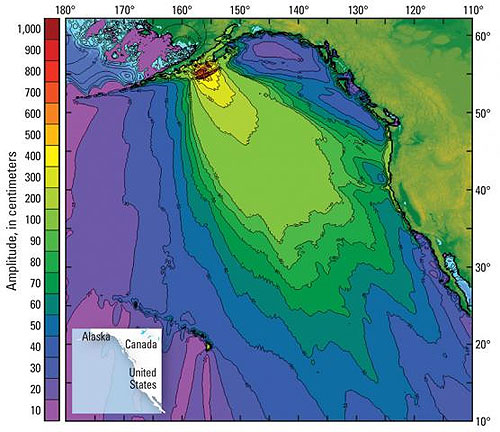
Imagine: A great Alaska earthquake meets southern CaliforniaBy NED ROZELL
February 10, 2014
On Thursday, March 27, 2014, a slab of the seafloor larger than human imagination fractures, rumbling beneath the Alaska Peninsula. In several planet-ringing minutes, thousands of years of potential energy releases to become kinetic. A great earthquake occurs right where scientists predicted it would. The Pacific floor plows beneath Alaska in the region between Kodiak Island and the Shumagin Islands south of Sand Point. A block of sea floor the size of Kodiak Island rises. A bulge in the Pacific Ocean rebounds toward Los Angeles. This graphic shows the immediate effect of a hypothetical 9.1 earthquake occurring off the Alaska Peninsula. The wave from the magnitude 9.1 earthquake outpaces an Alaska Airlines jet flying from Anchorage to Seattle. In the open ocean, the mass of tumbling water from whitecaps to ocean floor is a slight swell not noticed by the captain of a container ship halfway on his journey from China to Los Angeles. As the wave slows over the shallower waters of the continental shelf, its terrifying head rises from the depths. The sea floor shoves it 10 feet toward the sky as the wave passes Vancouver Island. The people of Los Angeles see and hear the warnings on their smartphones, televisions and car radios. Before Indonesia in 2004, tsunamis were an abstraction, but images of that tsunami and Japan in 2011 have made some wonder, as author Simon Winchester wrote, “whether the geological consent that permits them to inhabit so pleasant a place might be about to be withdrawn.” Los Angeles prepares for this unwanted export from the Aleutian Trench. Much of the city is beyond the reach of the mass of water that will soon slosh over the shallows, but the twin ports of Los Angeles and Long Beach cannot run for high ground. Here is where, in an event with many impacts, we look at the economic. All 314 million Americans have an intimate relationship with the largest and second-largest ports in the United States. Each day, Star Wars cranes in the 4,300-acre port of Los Angeles and neighboring 3,200-acre port of Long Beach lever from ships to railcar and truck more than 40,000 shipping containers. In those 20-to-40-foot metal boxes are jeans, tablet computers, bananas, cement, baseball gloves, coffee beans and office chairs that will soon be in stores across America. The tide is high in Los Angeles. This increases the punch of the wave. Despite the warning, not all of the 35 ship commanders are able to motor their sluggish machines to the safety of the open sea. As the first waves blows into the port, ships ride crazy currents caused by port geometry. Like bathtub toys, they crash into each other, wharfs and cranes. In staging areas on the inland side of the ports, more than 2,500 Japanese and Korean cars awaiting rides to dealerships from Fairbanks to Orlando are suddenly awash in salt water. One thousand metal containers full of stuff are soaked. In the days to weeks following the tsunami it takes to reopen the port, as much as $4 billion dollars will not get exchanged. Millions of items we use everyday are either soaked with brine or are stranded beyond our reach. Those billions might be greatly reduced if we have enough similar goods stored in dry warehouses and if ships that escaped the harbor and those waiting to come in can deliver their goods soon after, said Anne Wein of the U.S. Geological Survey in Menlo Park, California. Wein, a mathematician, is one of many researchers, including the University of Alaska Fairbanks tsunami modelers Dmitry Nicolsky and Elena Suleimani, who on their computers created an earthquake that cracks offshore of Alaska on the 50th anniversary of the Great Alaska Earthquake of 1964. The scientists wrote chapters about the damage this tsunami would do to everything from ecosystems to the economy. The narrative of an event that has not yet happened is an unusual product for scientists. The possible earthquake of March 27, 2014 is an attempt to “try to get out of our comfort zone and translate the science to make it accessible to decision makers,” Wein said.
E-mail your news &
photos to editor@sitnews.us
|
||
